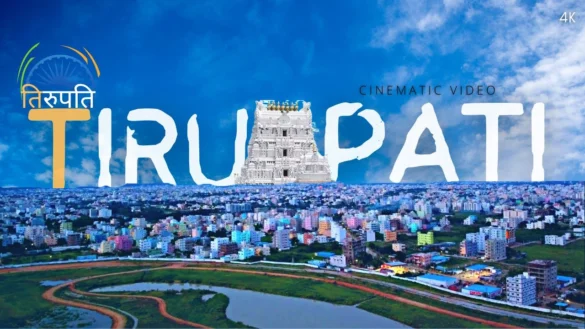Tirupati is a city in Andhra Pradesh, India, that is home to the Tirumala Venkateswara Temple, one of the most important Hindu pilgrimage sites in the world. The temple is dedicated to Venkateswara, a form of Vishnu, and is believed to have been built in the 3rd century AD.

The history of Tirupati is long and complex, and there are many legends and myths associated with the city. One legend tells the story of how the temple was built by Raja Thondaman, a local ruler. According to the legend, Raja Thondaman was childless, and he prayed to Vishnu for a son. Vishnu appeared to Raja Thondaman in a dream and told him that he would grant his wish, but only if he built a temple in his honor. Raja Thondaman agreed, and he built the Tirumala Venkateswara Temple.
Another legend tells the story of how the temple was saved from destruction by a Muslim ruler. According to the legend, a Muslim ruler was planning to destroy the temple, but he was stopped by a miracle. The night before the destruction was to take place, the temple was surrounded by a bright light, and the Muslim ruler was blinded. The ruler was so frightened that he gave up his plans to destroy the temple.
The history of Tirupati is also marked by periods of decline and revival. The temple was damaged by invaders on several occasions, but it was always rebuilt. In the 11th century, the temple was revived by Ramanujacharya, a Vaishnava saint. Ramanujacharya is credited with popularizing the worship of Venkateswara, and he helped to make Tirupati one of the most important pilgrimage sites in India.
Today, Tirupati is a thriving city that is home to millions of pilgrims every year. The Tirumala Venkateswara Temple is one of the richest temples in the world, and it is a major economic driver for the region. Tirupati is also a popular tourist destination, and it is home to a number of other temples and religious sites.
The History of Tirupati
The history of Tirupati can be traced back to the 3rd century AD, when the first temple dedicated to Venkateswara was built. The temple was built by Raja Thondaman, a local ruler, who was childless. According to legend, Vishnu appeared to Raja Thondaman in a dream and told him that he would grant his wish for a son, but only if he built a temple in his honor. Raja Thondaman agreed, and he built the Tirumala Venkateswara Temple.
The temple was damaged by invaders on several occasions, but it was always rebuilt. In the 11th century, the temple was revived by Ramanujacharya, a Vaishnava saint. Ramanujacharya is credited with popularizing the worship of Venkateswara, and he helped to make Tirupati one of the most important pilgrimage sites in India.
In the 16th century, Tirupati was ruled by the Vijayanagara Empire. The Vijayanagara rulers were patrons of the temple, and they made many contributions to its upkeep and development. In the 17th century, Tirupati was conquered by the Mughal Empire. The Mughal rulers were not as supportive of the temple as the Vijayanagara rulers, but they did not interfere with its worship.
In the 18th century, Tirupati was ruled by the Maratha Empire. The Maratha rulers were also patrons of the temple, and they made many contributions to its upkeep and development. In the 19th century, Tirupati was ruled by the British Empire. The British rulers were not as supportive of the temple as the Maratha rulers, but they did not interfere with its worship.
In the 20th century, Tirupati became a major pilgrimage site. Millions of pilgrims visit the temple every year, and it is one of the richest temples in the world. Tirupati is also a popular tourist destination, and it is home to a number of other temples and religious sites.
The Importance of Tirupati
Tirupati is one of the most important pilgrimage sites in India. The Tirumala Venkateswara Temple is dedicated to Venkateswara, a form of Vishnu, and it is believed to be one of the most powerful temples in the world. Millions of pilgrims visit the temple every year, and it is a major economic driver for the region.
Tirupati is also a popular tourist destination. The city is home to a number of other temples and religious sites, as well as a number of historical and cultural attractions. Tirupati is a beautiful city with a rich history, and it is a great place to visit for a pilgrimage or a vacation.
Ancient Origins and Mythical Legends
- The mythical origins of Tirupati: Legends and folklore surrounding the divine manifestation of Lord Venkateswara and the sacred hills of Tirumala.
- Historical references in ancient scriptures: References to Tirupati in Puranas, Epics, and other ancient texts, establishing its significance as a revered pilgrimage site since time immemorial.
- Significance of Tirumala Hills: The spiritual importance of the seven hills of Tirumala and their association with Lord Venkateswara.
Dynastic Rule and Patronage
- Influence of Pallavas and Cholas: The reign of Pallavas and Cholas and their contributions to the development of Tirupati as a prominent religious center.
- The Vijayanagara Empire: The golden era of Tirupati’s history, marked by the patronage of the Vijayanagara Empire, their contributions to temple architecture, and the establishment of temple administration.
- The Reddy and Nayakas: The impact of the Reddy and Nayaka rulers on Tirupati’s cultural and architectural heritage.
Influence of Nayaka and Maratha Rule
- After the decline of the Vijayanagara Empire, Tirupati came under the rule of the Nayaka dynasty. The Nayakas made significant contributions to the temple’s development and administration, further solidifying its importance as a religious center.
- The Marathas, under the leadership of Chatrapati Shivaji, had a short-lived rule over Tirupati. However, their influence can still be seen in the town’s architecture and cultural practices.
British Era and Temple Renovations
- During the British colonial period, Tirupati faced challenges due to changes in governance and administration. However, the British recognized the temple’s religious significance and provided support for its maintenance.
- Several renovations and restorations were carried out during this time to preserve the temple’s architectural beauty and historical value.
Temple and Community During Independence Movement
- Tirupati and its temple played a significant role during India’s struggle for independence. The temple became a center for social and cultural gatherings, fostering a sense of unity and promoting the spirit of nationalism.
- Many religious and spiritual leaders from Tirupati actively participated in the freedom movement, spreading the message of independence and social reform.
Architectural Marvels and Temple Development
- Evolution of the Sri Venkateswara Temple: The gradual transformation of the temple complex, from its humble beginnings to its present-day grandeur.
- Dravidian architectural style: Elaboration on the distinctive Dravidian architectural features showcased in the Sri Venkateswara Temple.
- Temple precincts and structures: Exploring the intricate carvings, mandapams, gopurams, and other architectural elements within the temple complex.
Temple Administration and Philanthropy
- Establishment of the Tirumala Tirupati Devasthanams (TTD): The role of TTD in the administration, management, and preservation of the temple and its various initiatives.
- Contributions of devotees: The deep-rooted tradition of philanthropy among devotees and their generous offerings to the temple.
- Social and welfare programs: Highlighting the initiatives undertaken by the temple administration for the welfare of the community.
Cultural Significance and Festivals
- The cultural tapestry of Tirupati: The amalgamation of art, music, dance, and literature in the town’s cultural landscape.
- Festivals and celebrations: Insight into the vibrant festivals celebrated in Tirupati, including Brahmotsavam, Vaikunta Ekadasi, and Rathotsavam.
- Rituals and customs: Describing the intricate rituals and customs performed at the Sri Venkateswara Temple, reflecting the devotion and spirituality of the pilgrims.
Modern Developments and Visitor Experience
- Infrastructure and amenities: The growth of Tirupati as a modern pilgrimage destination, with improved transportation, accommodation facilities, and visitor services.
- Tourism and economic impact: The significant contribution of pilgrim tourism to the local economy and the development of supporting industries.
- Technological advancements: The incorporation of modern technologies, such as online bookings and crowd management systems, to enhance the visitor experience.
Accommodation Options
- Tirupati offers a wide range of accommodation options to cater to the needs and budgets of the visiting pilgrims. There are numerous hotels, guesthouses, lodges, and resorts available in and around the town.
- The Tirumala Tirupati Devasthanams (TTD) also provides various accommodation facilities, including guesthouses and cottages, managed by the temple administration. These accommodations are often preferred by devotees due to their proximity to the temple and the availability of basic amenities.
Annadanam (Food Offering) Services
- Annadanam, the sacred practice of offering free food to devotees, is an integral part of the spiritual experience in Tirupati. The TTD operates large-scale Annadanam centers where meals are served to pilgrims throughout the day.
- The Annadanam centers provide hygienic vegetarian meals to thousands of devotees, ensuring that no one goes hungry. This service is a manifestation of the belief in selfless service and the importance of providing sustenance to all who visit the temple.
Transportation and Pilgrim Services
- Tirupati has well-established transportation services to facilitate the movement of pilgrims. Buses, taxis, and auto-rickshaws are readily available for local transportation within the town and for travel to and from Tirumala.
- The TTD also operates free bus services that transport devotees from Tirupati to the temple in Tirumala. These buses run at regular intervals and help manage the crowd and ease the journey for pilgrims.
- Additionally, there are dedicated information centers, counters, and helpdesks set up by the TTD and other organizations to assist visitors with their queries, guidance, and other services related to their pilgrimage.
Medical Facilities and Emergency Services
- Tirupati is equipped with medical facilities to ensure the well-being of pilgrims. There are hospitals, clinics, and pharmacies available for medical assistance.
- The TTD operates mobile medical vans and first aid centers in and around the temple premises to provide immediate medical attention to devotees in case of emergencies.
- Emergency services such as ambulance facilities and a dedicated helpline are also available to address any medical emergencies or situations requiring assistance.
Modern Preservation Efforts and UNESCO Recognition
- In recent years, the Tirumala Tirupati Devasthanams (TTD) and other organizations have taken steps to preserve and protect the heritage of Tirupati. Efforts include restoration projects, documentation of historical artifacts, and the establishment of a heritage museum.
- The Sri Venkateswara Temple in Tirupati has gained international recognition for its cultural and architectural significance. In 2019, it was inscribed on UNESCO’s tentative list of World Heritage Sites.
Contributions of Devotees and Pilgrim Tourism
- The devotion and contributions of millions of devotees have played a crucial role in the growth and maintenance of Tirupati. Their offerings, both financial and in the form of services, have helped sustain the temple and support various charitable endeavors.
- Pilgrim tourism remains a significant economic driver for the region, with millions of visitors from across India and the world visiting Tirupati each year. This influx of tourists has led to the development of infrastructure, hotels, and other supporting facilities.
Conclusion
Tirupati’s history is a testament to the profound spirituality and cultural heritage that defines this sacred town. From its mythical origins to its architectural splendors, Tirupati continues to draw millions of devotees from all over the world. The Sri Venkateswara Temple stands as a symbol of devotion, offering solace and spiritual rejuvenation to those who seek its divine grace. The rich history and timeless traditions of Tirupati make it a treasure trove of cultural significance and an eternal source of inspiration. As the spiritual legacy of Tirupati lives on, pilgrims and visitors alike are invited to immerse themselves in the captivating history and spiritual aura of this revered pilgrimage site.

